Isn’t cinema wonderful? It’s a series of images captured on film or digitally that has the ability to tell a story. Yes, a filmmaker can use audio to make this storytelling easier. But in the times of silent cinema, the image was all they had! Aside from the occasional interstitial, we are able to see Buster Keaton or Charlie Chaplin performing and innately understand what’s happening. What I’m attempting to convey is that cinematography, in all its density, can be boiled down to a singular concept: can a set of images tell a story on their own? The best of them can, without question. And I can distinctly remember the first time that was really made clear to me.

It was the first time I saw Jonathan Demme’s 1991 masterpiece, The Silence of the Lambs. And lo and behold, in the titular scene, it felt like I had peered into a new world of understanding cinema. Hannibal Lecter (Anthony Hopkins) is behind bars speaking to Clarice Starling (Jodie Foster). The camera set-up is simple. It’s a standard shot-reverse shot, solely focused on the immediate face of each character. But the effect it has on the viewer? Immensely powerful. For Hannibal, the bars are just peeking into the frame. For Clarice, it’s just her, front and center. But over time, as Hopkins delivers his chilling monologue, questioning Foster’s special agent, there’s a shift. Hannibal is shown to have the upper hand, and all that’s done on Demme’s (and the brilliant Tak Fujimoto’s) part is the camera zoom shifts to reveal bars around Clarice, whereas Hannibal appears free and in the open. If played silently, the intensity of both performers is captured in such a way by Demme and Fujimoto that we understand their dynamic on a fundamental level. Hannibal may be the one in the cage physically, but psychologically, Clarice doesn’t have nearly as much free reign as she might expect. It’s one of the many stand-out sequences to be found in that particular film, but a prime example of a scene that has remained memorable for decades.

Cinematography can be treated as a catch-all term by audiences at times. To imply something has good cinematography boils down to some as “the imagery is beautiful.” And that’s understandable! After all, for a visual medium, one would hope that the image we see is, in fact, lovely to look at. But what if the images in a particular film are meant to unsettle us? What if the camera is being used not to pull us into a new world, but keep us at bay? A Gaspar Noé film is one that disorients us, and undoubtedly makes us uncomfortable at best, and despondent at worst. In the hands of a director like Paul Thomas Anderson or Spike Lee, we can feel at times as if we’re a phantom floating through a world separate in time and place from our own. In the hands of these acclaimed directors, and frequent cinematographer collaborators such as Robert Elswit or Ernest R. Dickerson, these directors hone their vision through the lens of a camera operated by absolute legends and pioneers in filmmaking history. And with this column, we will examine the works of some legends, as well as look for new contemporary voices in the exciting world of cinematography.





